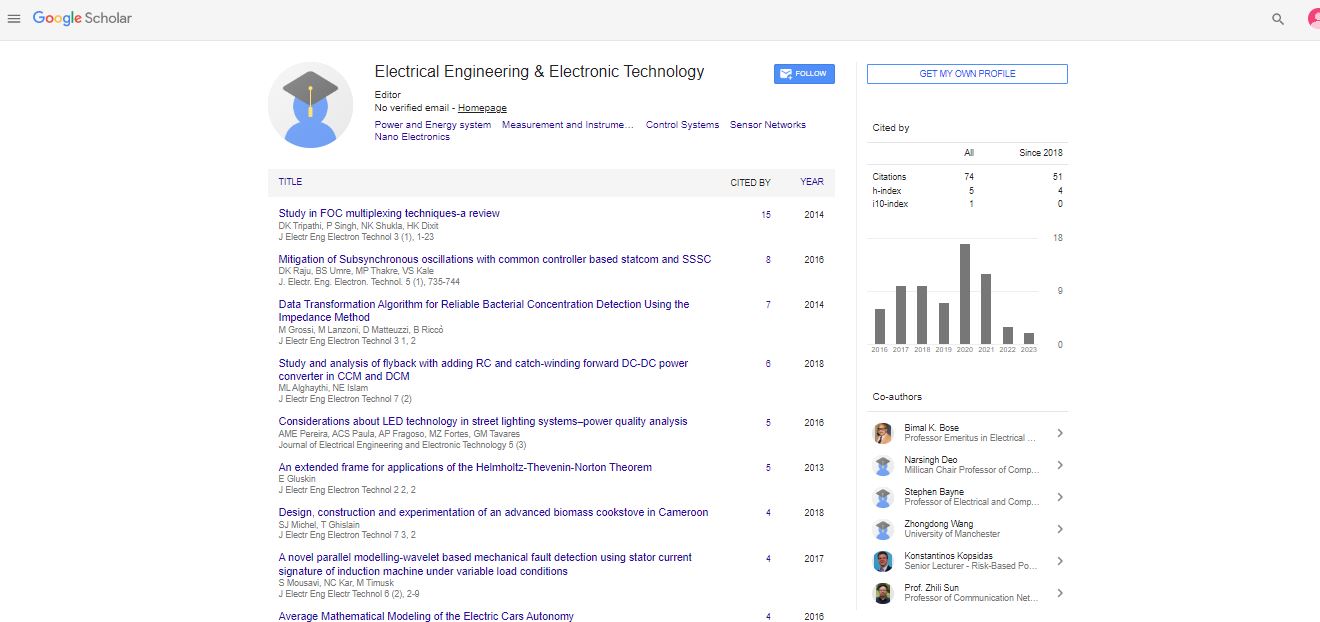Editorial, J Electr Eng Electron Technol Vol: 14 Issue: 1
The Three-Phase System: Powering the Modern World
Maria Wurm*
Department of Electrical Engineering, University of Zurich, Switzerland
- *Corresponding Author:
- Maria Wurm
Department of Electrical Engineering, University of Zurich, Switzerland
E-mail: wurm946@gmail.com
Received: 01-Jan-2025, Manuscript No. jeeet-25-169999; Editor assigned: 4-Jan-2025, Pre-QC No. jeeet-25-169999 (PQ); Reviewed: 18-Jan-2025, QC No. jeeet-25-169999; Revised: 25-Jan-2025, Manuscript No. jeeet-25-169999 (R); Published: 30-Jan-2025, DOI: 10.4172/2325-9838.1000988
Citation: Maria W (2025) The Three-Phase System: Powering the Modern World. J Electr Eng Electron Technol 14: 988
Introduction
The three-phase system is a method of alternating current (AC) electric power generation, transmission, and distribution. It is widely used around the world due to its efficiency and reliability in delivering electricity, especially for industrial and commercial applications. Unlike single-phase systems, which deliver power through a single alternating voltage, the three-phase system uses three alternating voltages of equal frequency and amplitude, but offset in time by one-third of a cycle (120 degrees) [1]. This results in a continuous and balanced power supply that is ideal for powering heavy machinery, large motors, and electrical grids [2].
Discussion
A three-phase system consists of three conductors carrying alternating currents that reach their peak values at different times. There are two main configurations of three-phase systems: star (wye) and delta. In the star connection, one end of each of the three windings is connected to form a common neutral point. In the delta connection, the windings are connected end-to-end to form a closed loop [3].
One of the key advantages of a three-phase system is its ability to deliver more power with less conductor material compared to a single-phase system. This makes it more cost-effective for power transmission over long distances. In addition, the power delivered by a three-phase system is constant, which reduces vibration and wear in electric motors, leading to smoother operation and longer lifespan of equipment [4].
Three-phase systems are particularly important in industrial settings. Motors and machines designed to operate on three-phase power are more compact, efficient, and powerful. For example, a three-phase induction motor is self-starting and does not require additional components like capacitors or starting windings, which are necessary in single-phase motors.
In power generation and transmission, the three-phase system is the global standard. Most power plants generate electricity in three phases, and this configuration continues through the transmission lines to substations. At the consumer level, industrial and commercial buildings usually receive three-phase power, while residential buildings may receive only one or two of the phases, depending on local utility practices [5].
The system also provides flexibility. By using a transformer, three-phase power can easily be stepped up or down in voltage for transmission or distribution. Additionally, it allows for both single-phase and three-phase loads to be connected, offering great versatility in usage.
Conclusion
The three-phase system is the backbone of modern electrical power systems. Its design ensures efficient power generation, transmission, and distribution while supporting the high demands of industrial applications. With benefits such as continuous power delivery, efficient use of materials, and the ability to run powerful motors and machines, it is clear why the three-phase system remains the preferred method for large-scale electrical power systems. As global demand for electricity continues to grow, especially with the expansion of industries and renewable energy sources, the importance of the three-phase system will only increase. Understanding its principles and advantages is essential for anyone involved in the field of electrical engineering or energy management.
REFERENCES
- Eigenbrode SD (2007). Employing philosophical dialogue in collaborative science. Bioscience. 57: 55-64.
- Fiksel J (2014). The triple value model: a systems approach to sustainable solutions Clean Technol. Environ Policy. 16: 691-702.
- Glika DC (2007). Risk communication for public health emergencies. Annu Rev Public Health. 28: 33-54.
- Hoover E (2015). Social science collaboration with environmental health Environ. Health Perspect. 123: 1100-1106.
- Maxwell K (2014). Getting there from here Nat. Clim Chang. 4: 936-937.
Indexed at, Google scholar, Cross ref
Indexed at, Google scholar, Cross ref
Indexed at, Google scholar, Cross ref
 Spanish
Spanish  Chinese
Chinese  Russian
Russian  German
German  French
French  Japanese
Japanese  Portuguese
Portuguese  Hindi
Hindi 
